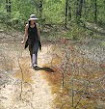"Mary Gartshore has been practicing ecological restoration for over 20 years based from her native plant nursery, Pterophylla Native Plant and Seed, which she shares with her partner Peter Carson near Walsingham. At the annual Thames Talbot Talk she inspired an audience of 140 people with her knowledge, enthusiasm and lessons learned to help nature. ...Ecological restoration is an intentional activity to assist in the recovery of an ecosystem for its health, integrity and sustainability. ...Usually an area to be restored has been degraded, damaged, or destroyed. ...She began her presentation with a quote by Aldo Leopold: “The first rule of intelligent tinkering is to save all the pieces.” Where did she learn about large-scale ecological restoration? Years ago, Mary was involved in a project in South Africa, where 870 000 ha of land was cleared of exotic species by manual methods."The full article by Bonnie Bergsma, mentions several of Mary's large-scale ecological restoration projects from her early work in South Africa to Red Hill Valley near Hamilton.
(Ok - here's why I'm so satisfied to read anything about Mary's work in Africa. It's been a dropped thread of curiousity to me ever since the 1st day I met her. I remember exactly where I left it: near the end of a generous, intensely inspiring, educational and mind-blowing full day of listening to and talking with Mary -- she's a natural born educator, content-rich to say the least, accomplished and still as inquisitive as youth itself, warm, approachable (she rolls well with, or without, questions) -- at a Nature Conservancy of Canada event around her farm, when she mentioned her conservation "work in africa" as not as much as a phrase in a sentence, and I finally, audibly, bursted "Holy shit! Can you believe how heavy this woman is?!" to a crowd of about 25 people. Yup. And oh, later I happened to read that she's a zoologist too).
The write-up also includes these points from her presentation on "Seven Steps to Successful Restoration":
1. Find an undisturbed reference site that approximates what you want to restore.I'd like to know more about those points. So I was sorry I missed that presentation. But about 20 minutes after thinking "that's the kind of speak I'd like to see her go on tour with" I noticed this in the Norfolk Field Naturalist site's (aka, the 1st place I go online to get a peak into what she and Peter might be thinking about lately; the Long Point Basin Land Trust site is worth trying too) 2010 events calendar:
2. Develop a list of representative species of the reference site.
3. Establish biodiversity targets, goals and strategies for assisting the restoration process.
4. Describe the successional trajectory or pathway that the restoration will take over time, including biotic and abiotic elements.
5. Begin seed collection and establish protocols for management.
6. Implement the operational plan.
7. Monitor for success."
Meeting: Principles and Practices of Large-Scale Ecological Restoration in Southern Ontario
Tuesday, January 12 2010
Mary Gartshore, Pterophylla
Simcoe ON
Simcoe Seniors Centre, Pond Street.
Doors open at 7:15PM, begins at 7:30PM
Large-scale ecological restoration can seem expensive and daunting to many people. This illustrated talk will summarize the rationale for ecological restoration on post- industrial and agricultural lands. Mary will provide conceptual steps in carrying out a restoration and demonstrate practical hands-on procedures and equipment. Finally, examples of projects spanning from 1 to15 years will be used to illustrate the expected (and unexpected) biodiversity results from her projects.Yes, I do know that's a 2 hour drive (one way, in good weather) from Toronto, but I'm thinking about it. :) Ok, I'm there. And to be safe, it's more like leaving TO by 3PM because of afternoon traffic. [update: yes, i went and it was worth it. She doesn't really do speaking tours, so you have to go to her turf to hear her.]
BTW: I was looking up Kayanase's native plant and seed nursery, a not-for-profit ecological restoration and native plant and seed business based in the Six Nations of the Grand River Territory community where Mary is an Associate Advisory Consultant, and noticed their write-up for the restoration at the Red Hill Valley and saw a few facts I didn't know: the Red Hill Valley project is "one of the largest ecological restoration projects ever undertaken in a major urban setting in North America. The ecological restoration plans ...include seeding and planting of over 1,000,000 native trees, shrubs, and forbs, established from local wild-type seed collected from within 75 kilometers of the project site." -- That's some seriously cool and advanced, uh, stewardship and native plant gardening ;)
When I think of Mary Gartshore, I'm wishing that some one was doing the bio/documentary.


1 comment:
This is a great profile for a woman who has inspired me and countless of other people I run across in this field. I'd recommend to anyone to tours some of the amazing properties that Mary and Peter have helped heal down by Long Point. Thanks for the profile, Native Plant Girl. Ben
Post a Comment